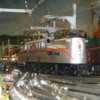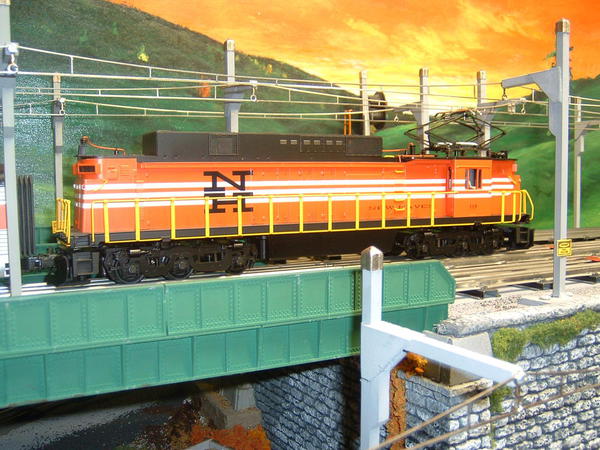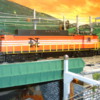Replies sorted oldest to newest
try some contact cleaner
Glenn,
Are you certain that the pants themselves aren't locked down?
Also, are you operating under DC or conventionally? Some additional information would go a long way. I'd also suggest moving this thread to the DCS/PS2/PS3 Forum.
Barry, thank you. Stay clear of the motor with contact cleaner. Do not use. The motor is sealed and it will not help. I have a couple of those locomotives and here is the crazy thing that will get you working. Remove the motor and gearbox (2 screws) from the locomotive. Looking inside the gearbox at the motor shaft you will see a very small gear that goes on the motor shaft. Take an Xacto or dental pick and move the gear one full turn in each direction. Put it back in your locomotive and give it a go. Whenever you pull a pan or what I mentioned, always do so with the pan in the up position. These motors are built like smoke fan motors. Only work the small gear I mentioned and nothing else.
The photo is not the best but look for the gear mentioned to be circled.
Attachments
Barry, we always run under dcs. And the pans are not locked down.
I've had trouble with mine also. I wish MTH would not use the automatic pans. How hard is it to pull the pan up by hand. Also many electrics have the wrong pan raise. Many Milwaukee motor ran with the front pan up. Don
I just bought a MTH Little Joe and could not wake my pantographs up either. I will try the gear trick.
I hear no motor noise.
I have three MTH Joes and one by one they all failed the pantograph test. Don
Don, the MTH GG-1 had them correct. On cold icy days, the PRR would raise the front pan to clear ice from the contact wire. I could also do without the operating pans. The one exception is when I run triple headed G motors it is cool to watch all three operating together up and down. Like you Don, I run under live wire and the look of these in action is very cool.
FYI for those with operating pans, the drive belt is a standard #14 O ring from Home Cheapo or Lowes. Gunrunner needed some earlier this year and that was the outcome to get him some.
Don, you are familiar with the motor and gearbox. I always hit them with voltage before taking the gearbox/motor out. Most of the time they will not move. Hitting the gear and changing the brushes against the motor will put you in business.
Thanks Marty. I have half a dozen MTH electrics and the failure rate on automatic pans is about 50%. I'll pull one of the non-working ones apart and try your solution. Working on the pan motors is a PITA job because you have to put the locomotive back together to see if whatever you did actually worked.
On another point, some of the MTH locomotives raise the correct pan for each direction and some don't. I just switch the leads to the pan motors to get the correct pan for each direction. The Milwaukee Road boxcabs raise the rear pan in forward, which is correct for a Bi-Polar but not a boxcab.
Also, if you don't have a new enough version of the firmware in your TIU and handheld control, you won't be able to switch between auto pan operation and manual. I had this problem when I got a Proto-3 electric - I couldn't get the auto/manual pan options to come up on the display. Several experts swore that the firmware version I had should have worked with 3.0 - but it didn't, and when I upgraded my firmware to the latest version, it worked just like it was supposed to.
Version never seemed to be a problem. MTH first came out with operating pans many years ago with the early PS-2 5 volt boards. Most of my electrics are eastern roads. I do have a MLW Bi-Polar and South Shore Little Joe.
Remember one more board exists for operating pans. The pantograph control board. They do go but not often.
Attachments
Glenn,
Have you checked the pans on/off switch, most likely on the bottom of the engine?
Also, have you tried the pans in both AUTO(up and down with direction changes) and Manual mode (using the pans soft keys)?
Yes, we have checked the on off switches, as well as the auto vs manual modes. For most of the engines the pantograph motors actually are working, but the pans will not move. Perhaps this is an issue of broken belt connections. For the engines where the motors will not work It sounds line there could be a number of problems.
On those with functioning motors, do you see the the slotted sliding lever underneath the pantograph move when the motor is running? It's hard to spot because the action is fairly quick. I have a South Shore Little Joe and one panto frequently gets detached from that part of the mechanism because it only has a small arm that fits in the slot. I think you have to cycle the motor to what's supposed to be the up position, then you can see the slot and fit the arm back into it. Even a slight knock will push it out to begin with.
If you don't see the movement then it might be that the pulley that works it has failed.
I've had trouble with mine also. I wish MTH would not use the automatic pans. How hard is it to pull the pan up by hand. Also many electrics have the wrong pan raise. Many Milwaukee motor ran with the front pan up. Don
Go into the soft key and select manual. You can operate them as you want. G
To summarize:
1. If unit has pantograph on off switch, make sure in on.
2. Make sure pantographs unlocked and that the tab that move the pantograph is properly engaged with the sliding block that moves it.
3. Test in conventional as this over rides DCS setting.
4. Remove shell and inspect wiring. Could have broken wire solder joint on motor.
5. Inspect for broke O ring drive belt.
6. Make sure 10 pin harness plugged into jumper board properly.
With shell off so you can see what is going on with pantographs, you can power engine and see if motor spins.
After the above it is hardware troubleshooting.
You can disconnect the 10 pin so the pantographs are not connected to board and then test motor with 9V battery.
As far as drive belts.
EG-3000000 is for GG-1 (but not all). Listed as 24.6mm belt
EG-3100000 is for Little Joe, EF, FF. GG-1 and is a 2mm x 21.5mm belt.
G
The rings I got from Marty worked perfectly, I've replaced the belts in two different units. I think the belts are probably one of the more common failure items from the look of them.
I've not been able to get our MTH GN boxcab set to let me use the manual function for the pans to make them go up or down manually. It just stays in auto mode, regardless. Resets didn't work, trial and error didn't hit on anything.
John, it is a standard # 14 O ring. Any plumbing department will have them on a bubble pack of 4 or 6. Guys, if you have pans that keep popping off, flip them upside down and do the following. You will see a silver colored side by side metal rod (yes I know they connect at the end) that snaps over the pantograph stud that mounts on the locomotive roof. Take your needle nose pliers and squeeze them together a bit so when you push the pan down on the stud you will feel a bit more resistance. That extra bit will keep your pan on the roof forever.
Attachments
Marty, after you told me, I found them at a second Lowes when I was in there looking for other stuff. ![]()
After I found them, I realized that I have a huge O-ring assortment from Harbor Freight, and it happens that one of the sizes are a perfect match as well. So, I had them all along, just didn't think of that source. ![]()
Barry, thank you. Stay clear of the motor with contact cleaner. Do not use. The motor is sealed and it will not help. I have a couple of those locomotives and here is the crazy thing that will get you working. Remove the motor and gearbox (2 screws) from the locomotive. Looking inside the gearbox at the motor shaft you will see a very small gear that goes on the motor shaft. Take an Xacto or dental pick and move the gear one full turn in each direction. Put it back in your locomotive and give it a go. Whenever you pull a pan or what I mentioned, always do so with the pan in the up position. These motors are built like smoke fan motors. Only work the small gear I mentioned and nothing else.
The photo is not the best but look for the gear mentioned to be circled.
Do I see an O-ring belt upon which the pulleys are not even close to alignment?
That looks wrong, I think the pulley may be on upside down. I don't remember the belt having that much misalignment.
I have an EP 3 which has the same problem. I did try the battery and the motor works. I need to look at the gears. If not, it is the board.
This motor is the same motor that is in the little battery operated screwdriver that many bought years ago.
John that is a junker I keep for parts.
OK, I was hoping that belt wasn't representative of how they should look! ![]() I'd have to take a couple apart if that's how it's supposed to look.
I'd have to take a couple apart if that's how it's supposed to look. ![]()
I had an MTH P-3 Swiss Kroc where the rear pan failed. Ended up selling it with FULL disclosure. ![]()
Apparently, MTH could have "tweaked" their design! ![]()
Fixing these small issues are very easy to do. The system is cool if you run wire. Running with wire requires a few very easy modifications to the pans. I had a fellow ask me where the sparks on the wire are when the train was running. I informed him that if you get sparks, you did a poor job on the pans and wire. Done right no sparks exist.
The only "live wire" pantograph operation I ever had was with LGB's later catenary system and their amazing digital sound RhB "Baby Krocodile" loco.
Very smooth operation and NO sparks thanks to rubbing the wires with LGB's conductive paste.
While the number isn't large by any means I have worked on about 10 engines with operating pantographs, GG, EF, FF.
Almost all the issues were operator error, or panto were fine. One bad motor, one with broken belts (storage probably the issue based on cobwebs and such on the engine), one broken wire.
G
Marty, the hard part isn't making the pans work, it's stringing the catenary properly so it works! ![]()
John, I did it to an existing layout and a large number of poles needed to be made to a custom configuration. I have several hundred feet of live wire. The job took me one year. I worked every day on it and it operates perfect. Mike Wolf studied my system before giving it a go. The key to sectional catenary is rock solid poles. My poles are 1/4 metal stock welded to 1 1/4 inch metal bases.
For operation, sectional catenary is the way to go. I have seen full floating catenary and when the locomotive is under the wire, the pan pushes the wire skyward. It looks crappy. That reminds me of a football game when people do the wave. Scale looking catenary is beautiful with all the pull off wires and hardware that goes with it. Being a toy train guy, Imy goal was to make my system look like something Lionel could have made in the 50's. My goal was perfect operation. I have that.
Like any other big job, do it right and do it one time.
Big Job being the operative word. ![]() Next time in bean-town, I am going to try to see this in person.
Next time in bean-town, I am going to try to see this in person. ![]()
John, only after you sign my wall.
I'm sure that can be arranged. One "X" or two? ![]()
![]()
I received a used little joe for Christmas and the pants would not work. After using Marty’s trick listed above, they are working great. Thanks for taking the time to post this fix on here!








